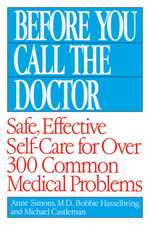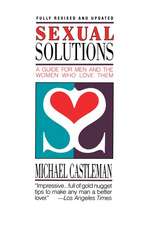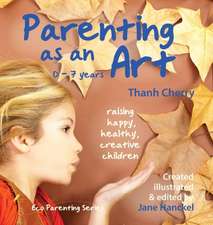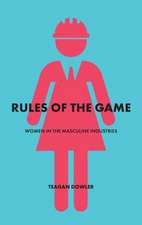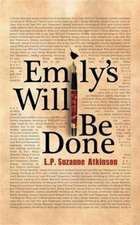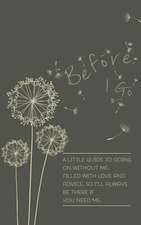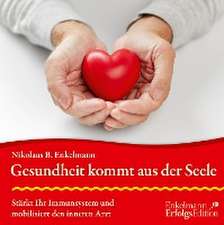The New Healing Herbs: Revised and Updated
Autor Michael Castlemanen Limba Engleză Paperback – 31 oct 2002
In this revised edition, The New Healing Herbs provides up-to-date profiles of 100 of the most widely used medicinal plants, detailing the therapeutic benefits and healing properties of each of these amazing natural cures. Inside you’ll find:
• Valuable advice for buying, storing, and preparing herbal remedies
• Clear, concise dosage instructions and safe-usage guidelines
• A comprehensive cure-finder chart with treatments for more than 100 common conditions--Ginkgo to improve and even reverse symptoms of macular degeneration...Cinnamon to treat cuts and scrapes...Marshmallow to boost immunity...St. John’s wort to speed healing...Coffee for weight loss...Ginger for colds...Apples as a source of first aid...And much more!
Preț: 62.66 lei
Nou
Puncte Express: 94
Preț estimativ în valută:
11.99€ • 12.49$ • 9.100£
11.99€ • 12.49$ • 9.100£
Carte indisponibilă temporar
Doresc să fiu notificat când acest titlu va fi disponibil:
Se trimite...
Preluare comenzi: 021 569.72.76
Specificații
ISBN-13: 9780553585148
ISBN-10: 0553585142
Pagini: 704
Ilustrații: APPROXIMATELY 100 B&W ILLUSTR.
Dimensiuni: 107 x 175 x 30 mm
Greutate: 0.34 kg
Ediția:Revised
Editura: Bantam
ISBN-10: 0553585142
Pagini: 704
Ilustrații: APPROXIMATELY 100 B&W ILLUSTR.
Dimensiuni: 107 x 175 x 30 mm
Greutate: 0.34 kg
Ediția:Revised
Editura: Bantam
Extras
Chapter 1
From Magic to Medicine
5,000 Years of Herbal Healing
In 1991, on a glacier in the Italian Alps that had melted back to an unusual extent, hikers stumbled on a dead body. It turned out to be the naturally mummified body of a prehistoric man who had frozen to death some 5,300 years before and whose remains were preserved in the ice.
Dubbed the Iceman, he’s been studied by Italian anthropologists ever since. He wore straw-lined leather shoes, leather clothing, a thick coat made from woven grass, and a bearskin cap. He carried a wooden bow, a leather quiver filled with stone-tipped arrows, a flint-bladed knife, a wood-handled ax with a copper blade, and a food pouch that still contained dried deer meat and a prune.
The Iceman’s pouch also contained two mysterious corklike lumps about the size of walnuts that were pierced through and strung together on a leather thong, indicating that they were of value. The lumps turned out to be bracket fungus (Piptoporus betulinus), one of many mushrooms that grow in shelflike plates on tree trunks.
This species of fungus contains agaric acid, a potent laxative, and an oily resin that is toxic to some bacteria and intestinal parasites.
The scientists studying the Iceman had no idea why he would have carried bracket fungus until, in 1998, a painstaking autopsy of his digestive tract turned up the eggs of an intestinal parasite (Trichuris trichiura) in his rectum.
It now appears that the Iceman knew he carried the parasite, which causes abdominal pain, and was using bits of bracket fungus to treat his condition. Given its laxative and antiparasitic action, the fungus probably provided some benefit.
This discovery ranks as the world’s oldest documented example of the practice of medicine, and it suggests that prehistoric humanity was more medically sophisticated than previously believed. After all, the Iceman or someone else had diagnosed his malady correctly and had recommended a reasonably appropriate treatment—an herbal treatment—around 3300 b.c.
Animal Attractions
Just what is a healing herb? The word herb comes from the Latin for “grass.” Technically, herbs are plants that wither each autumn, plants other than shrubs or trees. But many woody perennials are used in herbal healing, such as slippery elm, tea tree, and white willow. To an herbalist, the phrase “healing herbs” applies to every plant with medicinal value.
Prehistoric sites in Iraq show that the Neanderthals used yarrow, marshmallow, and other herbs some 60,000 years ago. What attracted them to these plants?
Animals played a key role. Prehistoric humans were keen observers of the world around them. No doubt our ancestors noticed that when animals appeared ill, they sometimes ate plants that they ordinarily ignored. Humans sampled these plants, in many cases noticing curious effects—wakefulness, sleepiness, laxative action, increased urination, and so on. The herbs that caused these effects were incorporated into prehistoric shamanism, and later into medicine.
Animal-inspired herbalism has continued into modern times. The controversial herbal cancer therapy marketed by Harry Hoxsey was reportedly inspired by a cancer-stricken horse who ate unusual herbs (more on this later).
Aromatic Magic
Early humans were also attracted to healing herbs’ aromas. They rubbed strong-smelling herbs on their bodies to repel insects and to hide their human scent from animals that they feared or hunted. They also adorned themselves with sweet-smelling herbs to please their mates.
Fragrant herbs evolved into the first perfumes and embalming mixtures. Demand for them spurred ancient trade. During the Middle Ages, when Europeans believed that bathing was unhealthy and farm animals often shared human living quarters, homemakers spread aromatic “strewing herbs” to freshen the air. Herbalists still prepare scent baskets (potpourris) today, and the perfume industry still creates most of its fragrances from herbal essences.
But foul odors, not fragrant ones, were key to the development of herbal healing. Early humans used plants such as rosemary, thyme, dill, and virtually all of today’s culinary spices to mask the stench of rotting meats. Today, we use culinary herbs and spices only as flavor enhancers, but to prehistoric humanity, flavor enhancement was incidental to food preservation.
Prehistoric humanity had no refrigeration, and meats spoiled quickly. Spoilage destroyed precious reserves, and early humans learned the hard way that eating rotten meats caused illness and sometimes death. No doubt some prehistoric homemaker happened to lay some rotting meat on a bed of wild mint, sage, basil, or some other aromatic herb, hoping the herb’s fragrance would mask the meat’s malodorousness. It did, and as a bonus, the meat didn’t spoil as quickly.
Our ancestors began wrapping meats in aromatic herbs to preserve them, which led to other astonishing discoveries. Those who ate preservative herbs along with meats suffered less illness. As an added benefit, the meats tasted better.
Surely, our ancestors must have decided, aromatic herbs were magic. As time passed and magic was incorporated into religion, ancient civilizations came to view aromatic herbs as gifts from the gods. This is why many herbs figure prominently in ancient myths and religions.
Thanks to modern science, we know that the oils that give aromatic herbs their fragrance and flavor contain antimicrobial compounds that kill many food-spoiling, disease-causing microorganisms. In fact, rosemary and sage have food-preservative action comparable to that of the commercial preservatives BHA and BHT.
Trial and Error
Our ancestors also discovered many healing herbs simply by trial and error. They learned through experience that some plants healed, while others harmed. They had little control over their world or their bodies. Their average life expectancy was barely 30 years. Because their lives were so full of threatening, often fatal, surprises, anything that made life more predictable acquired an aura of magic and healing.
It’s no coincidence that shamans from prehistoric times down to the present day have relied heavily on herbs, such as ipecac, buckthorn, and wormwood, that cause vomiting, purging, and hallucinations. Any predictable effect was better than none, and the ability to induce vomiting, purging, or visions made shaman/herbalists appear to possess magic powers.
The allure of predictable action remained central to medicine for thousands of years. Herbs that induced vomiting (emetics) or had powerful laxative action were used routinely in medicine until well into the 19th century.
Major effects made big impressions, but early humans also recognized herbs’ more subtle benefits. We’ll never know what possessed some ancient Chinese peasant to brew a tea from the small, ungainly stalks of ma huang (Chinese ephedra), but several thousand years ago, someone did. In the process, that person stumbled upon one of the world’s oldest medicines, a decongestant whose laboratory analog, pseudoephedrine, is still an ingredient in cold formulas today.
Similarly, we’ll never know how many roots ancient Asians dug up before they discovered ginger. Or why Native
Americans had a hunch that black cohosh might be useful in gynecology. All over the world, however, ancient peoples dug, dried, chewed, pounded, rubbed, and brewed the plants around them. In this way, they discovered the vast majority of healing herbs still in use today.
Isolated Cultures, Similar Herbs
Herbal trial and error becomes even more remarkable when we consider that cultures separated by thousands of miles arrived at similar uses for many healing herbs. What’s more, they apparently did so independently of one another.
There are four major herbal traditions: Chinese, Ayurvedic (in India), European (including Egyptian), and Native American. The spice trade clearly introduced Asian herbs such as garlic, ginger, and cinnamon into Europe thousands of years ago. And a few ancient herbalists—notably the 1st-century Greek Dioscorides—traveled extensively, spreading knowledge around the ancient world.
Nonetheless, early Chinese, Indian, and European herbalists were largely isolated from one another. In modern times, it’s difficult to comprehend just how isolated they were. Until the 1st century a.d., it took 2 years for spice traders to make the round trip from Greece to India’s black-pepper-producing region.
Even in this age of instant global communication, different healing systems still operate relatively independently of one another. During the 1970s and early 1980s, ginkgo became an important medicine in France and Germany for aging-related ailments, with sales topping $500 million a year. Most U.S. medical school libraries stocked the German and French journals showing ginkgo’s remarkable effectiveness, yet American physicians virtually ignored ginkgo well into the 1990s. So how connected could the ancient herbalists have been?
Even granting a nearly impossible level of herbal cross-fertilization between Asia and Europe, the land bridge between Asia and North America became the Bering Sea about 10,000 years ago. Until the 15th century, Old World cultures were almost entirely isolated from the Americas, but nonetheless, Old and New World herbalists used many herbs similarly.
•Angelica and licorice: Asians, Europeans, and Native Americans relied on these herbs as treatments for respiratory ailments.
•Hop and the mints: All of the ancient herbal traditions used these herbs as stomach soothers.
•Blackberry and raspberry: Around the world, these herbs played a role in treating diarrhea.
•Uva-ursi: Asians, Europeans, and Native Americans all discovered this herb’s diuretic properties.
•White willow: All of the herbal healing disciplines used this herb to treat pain and inflammation.
During the 19th century, chemists homed in on this “herbal convergence” to point them to the plants whose extracts became the first pharmaceuticals. According to a report in the journal Science, about 75 percent of the pharmaceuticals derived from plants came to drug companies’ attention because of their use in traditional herbal medicine.
Homage to the “Wise Women”
Most medical histories chronicle great achievements by great men: Hippocrates, the father of medicine; Galen, Rome’s leading physician; William Harvey’s explanation of blood circulation; Edward Jenner’s inoculations against smallpox; Louis Pasteur’s Germ Theory; Alexander Fleming’s discovery of penicillin.
The contributions of these men unquestionably changed the world. But from ancient times down to the present day, a relatively small number of male physicians made the great discoveries and ministered to the rich and royal. An enormous number of women herbalists took care of everyone else.
Women healers have gone by many names: midwives, wise women, green women, witches, old wives, and nurses. Most physicians have never taken women’s folk healing very seriously, and scientists often dismiss folk wisdom as “old wives’ tales.”
From Magic to Medicine
5,000 Years of Herbal Healing
In 1991, on a glacier in the Italian Alps that had melted back to an unusual extent, hikers stumbled on a dead body. It turned out to be the naturally mummified body of a prehistoric man who had frozen to death some 5,300 years before and whose remains were preserved in the ice.
Dubbed the Iceman, he’s been studied by Italian anthropologists ever since. He wore straw-lined leather shoes, leather clothing, a thick coat made from woven grass, and a bearskin cap. He carried a wooden bow, a leather quiver filled with stone-tipped arrows, a flint-bladed knife, a wood-handled ax with a copper blade, and a food pouch that still contained dried deer meat and a prune.
The Iceman’s pouch also contained two mysterious corklike lumps about the size of walnuts that were pierced through and strung together on a leather thong, indicating that they were of value. The lumps turned out to be bracket fungus (Piptoporus betulinus), one of many mushrooms that grow in shelflike plates on tree trunks.
This species of fungus contains agaric acid, a potent laxative, and an oily resin that is toxic to some bacteria and intestinal parasites.
The scientists studying the Iceman had no idea why he would have carried bracket fungus until, in 1998, a painstaking autopsy of his digestive tract turned up the eggs of an intestinal parasite (Trichuris trichiura) in his rectum.
It now appears that the Iceman knew he carried the parasite, which causes abdominal pain, and was using bits of bracket fungus to treat his condition. Given its laxative and antiparasitic action, the fungus probably provided some benefit.
This discovery ranks as the world’s oldest documented example of the practice of medicine, and it suggests that prehistoric humanity was more medically sophisticated than previously believed. After all, the Iceman or someone else had diagnosed his malady correctly and had recommended a reasonably appropriate treatment—an herbal treatment—around 3300 b.c.
Animal Attractions
Just what is a healing herb? The word herb comes from the Latin for “grass.” Technically, herbs are plants that wither each autumn, plants other than shrubs or trees. But many woody perennials are used in herbal healing, such as slippery elm, tea tree, and white willow. To an herbalist, the phrase “healing herbs” applies to every plant with medicinal value.
Prehistoric sites in Iraq show that the Neanderthals used yarrow, marshmallow, and other herbs some 60,000 years ago. What attracted them to these plants?
Animals played a key role. Prehistoric humans were keen observers of the world around them. No doubt our ancestors noticed that when animals appeared ill, they sometimes ate plants that they ordinarily ignored. Humans sampled these plants, in many cases noticing curious effects—wakefulness, sleepiness, laxative action, increased urination, and so on. The herbs that caused these effects were incorporated into prehistoric shamanism, and later into medicine.
Animal-inspired herbalism has continued into modern times. The controversial herbal cancer therapy marketed by Harry Hoxsey was reportedly inspired by a cancer-stricken horse who ate unusual herbs (more on this later).
Aromatic Magic
Early humans were also attracted to healing herbs’ aromas. They rubbed strong-smelling herbs on their bodies to repel insects and to hide their human scent from animals that they feared or hunted. They also adorned themselves with sweet-smelling herbs to please their mates.
Fragrant herbs evolved into the first perfumes and embalming mixtures. Demand for them spurred ancient trade. During the Middle Ages, when Europeans believed that bathing was unhealthy and farm animals often shared human living quarters, homemakers spread aromatic “strewing herbs” to freshen the air. Herbalists still prepare scent baskets (potpourris) today, and the perfume industry still creates most of its fragrances from herbal essences.
But foul odors, not fragrant ones, were key to the development of herbal healing. Early humans used plants such as rosemary, thyme, dill, and virtually all of today’s culinary spices to mask the stench of rotting meats. Today, we use culinary herbs and spices only as flavor enhancers, but to prehistoric humanity, flavor enhancement was incidental to food preservation.
Prehistoric humanity had no refrigeration, and meats spoiled quickly. Spoilage destroyed precious reserves, and early humans learned the hard way that eating rotten meats caused illness and sometimes death. No doubt some prehistoric homemaker happened to lay some rotting meat on a bed of wild mint, sage, basil, or some other aromatic herb, hoping the herb’s fragrance would mask the meat’s malodorousness. It did, and as a bonus, the meat didn’t spoil as quickly.
Our ancestors began wrapping meats in aromatic herbs to preserve them, which led to other astonishing discoveries. Those who ate preservative herbs along with meats suffered less illness. As an added benefit, the meats tasted better.
Surely, our ancestors must have decided, aromatic herbs were magic. As time passed and magic was incorporated into religion, ancient civilizations came to view aromatic herbs as gifts from the gods. This is why many herbs figure prominently in ancient myths and religions.
Thanks to modern science, we know that the oils that give aromatic herbs their fragrance and flavor contain antimicrobial compounds that kill many food-spoiling, disease-causing microorganisms. In fact, rosemary and sage have food-preservative action comparable to that of the commercial preservatives BHA and BHT.
Trial and Error
Our ancestors also discovered many healing herbs simply by trial and error. They learned through experience that some plants healed, while others harmed. They had little control over their world or their bodies. Their average life expectancy was barely 30 years. Because their lives were so full of threatening, often fatal, surprises, anything that made life more predictable acquired an aura of magic and healing.
It’s no coincidence that shamans from prehistoric times down to the present day have relied heavily on herbs, such as ipecac, buckthorn, and wormwood, that cause vomiting, purging, and hallucinations. Any predictable effect was better than none, and the ability to induce vomiting, purging, or visions made shaman/herbalists appear to possess magic powers.
The allure of predictable action remained central to medicine for thousands of years. Herbs that induced vomiting (emetics) or had powerful laxative action were used routinely in medicine until well into the 19th century.
Major effects made big impressions, but early humans also recognized herbs’ more subtle benefits. We’ll never know what possessed some ancient Chinese peasant to brew a tea from the small, ungainly stalks of ma huang (Chinese ephedra), but several thousand years ago, someone did. In the process, that person stumbled upon one of the world’s oldest medicines, a decongestant whose laboratory analog, pseudoephedrine, is still an ingredient in cold formulas today.
Similarly, we’ll never know how many roots ancient Asians dug up before they discovered ginger. Or why Native
Americans had a hunch that black cohosh might be useful in gynecology. All over the world, however, ancient peoples dug, dried, chewed, pounded, rubbed, and brewed the plants around them. In this way, they discovered the vast majority of healing herbs still in use today.
Isolated Cultures, Similar Herbs
Herbal trial and error becomes even more remarkable when we consider that cultures separated by thousands of miles arrived at similar uses for many healing herbs. What’s more, they apparently did so independently of one another.
There are four major herbal traditions: Chinese, Ayurvedic (in India), European (including Egyptian), and Native American. The spice trade clearly introduced Asian herbs such as garlic, ginger, and cinnamon into Europe thousands of years ago. And a few ancient herbalists—notably the 1st-century Greek Dioscorides—traveled extensively, spreading knowledge around the ancient world.
Nonetheless, early Chinese, Indian, and European herbalists were largely isolated from one another. In modern times, it’s difficult to comprehend just how isolated they were. Until the 1st century a.d., it took 2 years for spice traders to make the round trip from Greece to India’s black-pepper-producing region.
Even in this age of instant global communication, different healing systems still operate relatively independently of one another. During the 1970s and early 1980s, ginkgo became an important medicine in France and Germany for aging-related ailments, with sales topping $500 million a year. Most U.S. medical school libraries stocked the German and French journals showing ginkgo’s remarkable effectiveness, yet American physicians virtually ignored ginkgo well into the 1990s. So how connected could the ancient herbalists have been?
Even granting a nearly impossible level of herbal cross-fertilization between Asia and Europe, the land bridge between Asia and North America became the Bering Sea about 10,000 years ago. Until the 15th century, Old World cultures were almost entirely isolated from the Americas, but nonetheless, Old and New World herbalists used many herbs similarly.
•Angelica and licorice: Asians, Europeans, and Native Americans relied on these herbs as treatments for respiratory ailments.
•Hop and the mints: All of the ancient herbal traditions used these herbs as stomach soothers.
•Blackberry and raspberry: Around the world, these herbs played a role in treating diarrhea.
•Uva-ursi: Asians, Europeans, and Native Americans all discovered this herb’s diuretic properties.
•White willow: All of the herbal healing disciplines used this herb to treat pain and inflammation.
During the 19th century, chemists homed in on this “herbal convergence” to point them to the plants whose extracts became the first pharmaceuticals. According to a report in the journal Science, about 75 percent of the pharmaceuticals derived from plants came to drug companies’ attention because of their use in traditional herbal medicine.
Homage to the “Wise Women”
Most medical histories chronicle great achievements by great men: Hippocrates, the father of medicine; Galen, Rome’s leading physician; William Harvey’s explanation of blood circulation; Edward Jenner’s inoculations against smallpox; Louis Pasteur’s Germ Theory; Alexander Fleming’s discovery of penicillin.
The contributions of these men unquestionably changed the world. But from ancient times down to the present day, a relatively small number of male physicians made the great discoveries and ministered to the rich and royal. An enormous number of women herbalists took care of everyone else.
Women healers have gone by many names: midwives, wise women, green women, witches, old wives, and nurses. Most physicians have never taken women’s folk healing very seriously, and scientists often dismiss folk wisdom as “old wives’ tales.”
Recenzii
“I have been searching for a user-friendly, objective herbal guide for years. Michael Castleman has finally provided one! This book will tell you what you need to know about how to use nature’s medicines effectively.”
--Joe Graedon, author of The People’s Pharmacy
--Joe Graedon, author of The People’s Pharmacy
Descriere
This revised edition of the classic guide to herbal medicines provides up-to-date profiles of 100 of the most widely used medicinal plants, detailing the therapeutic benefits and healing properties of each. Features concise dosage instructions and safe-usage guidelines, advice for buying, storing, and preparing herbal remedies, and a comprehensive cure-finder chart with treatments for more than 100 common conditions.


